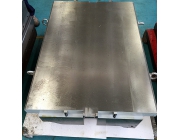

Longmen processing 02

Longmen processing 03

Longmen processing 04

Longmen processing 05

Longmen processing 06

Longmen processing 07

Longmen processing 08

Longmen processing 09

Longmen processing 01

Processing center of small proc

Processing center of small proc

Processing center of small proc

Processing center of small proc

Processing center of small proc

Processing center of small proc

Processing center of small proc


 the plastic deformation caused by the action of cutting force in the process of machined , which causes the lattice distortion, distortion, the shear slip between the grains, the grain being elongated and fibrosis, even broken, which all make the hardness and strength of the surface layer metal increase. This is the case. The image is called cold hardening (or strengthened). The strengthening of the surface layer will increase the resistance of the metal deformation, reduce the plasticity of the metal, and change the physical properties of the metal.
the plastic deformation caused by the action of cutting force in the process of machined , which causes the lattice distortion, distortion, the shear slip between the grains, the grain being elongated and fibrosis, even broken, which all make the hardness and strength of the surface layer metal increase. This is the case. The image is called cold hardening (or strengthened). The strengthening of the surface layer will increase the resistance of the metal deformation, reduce the plasticity of the metal, and change the physical properties of the metal. 